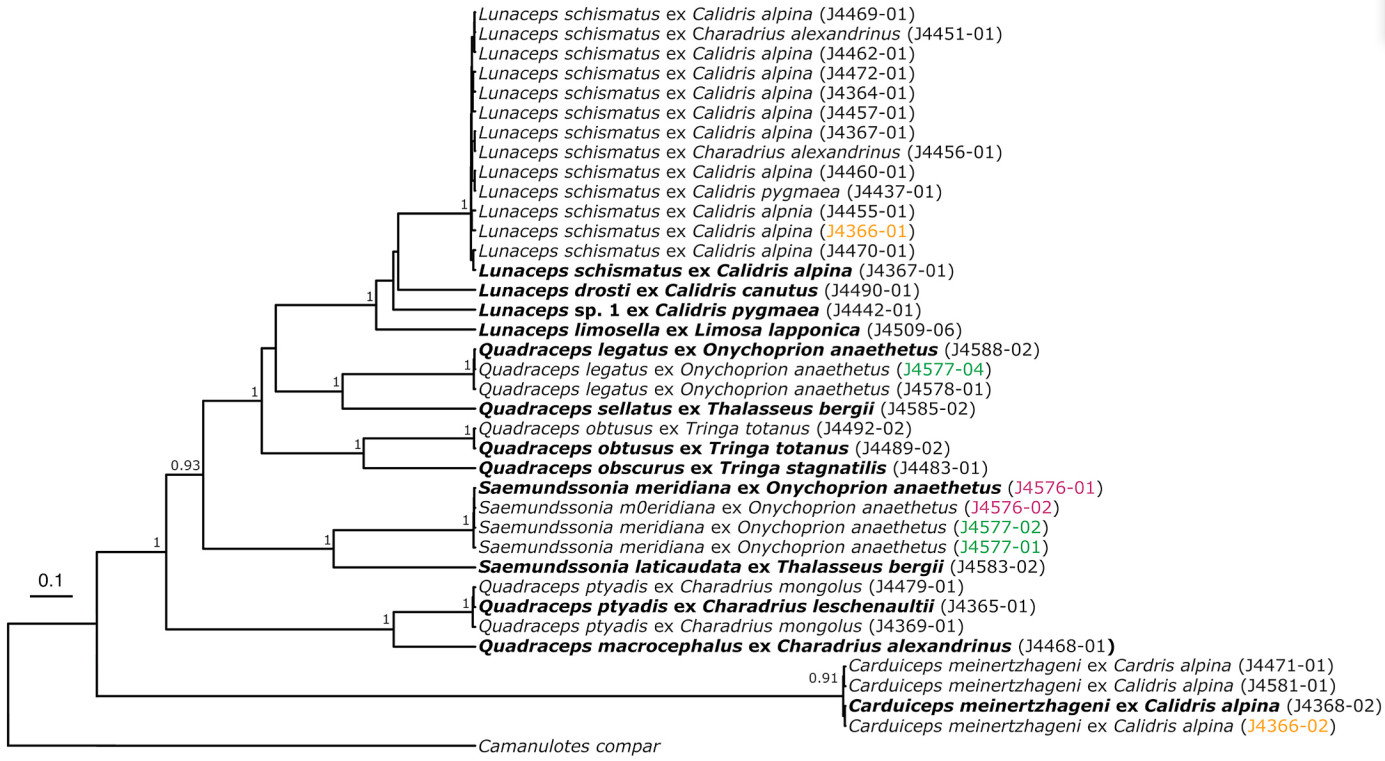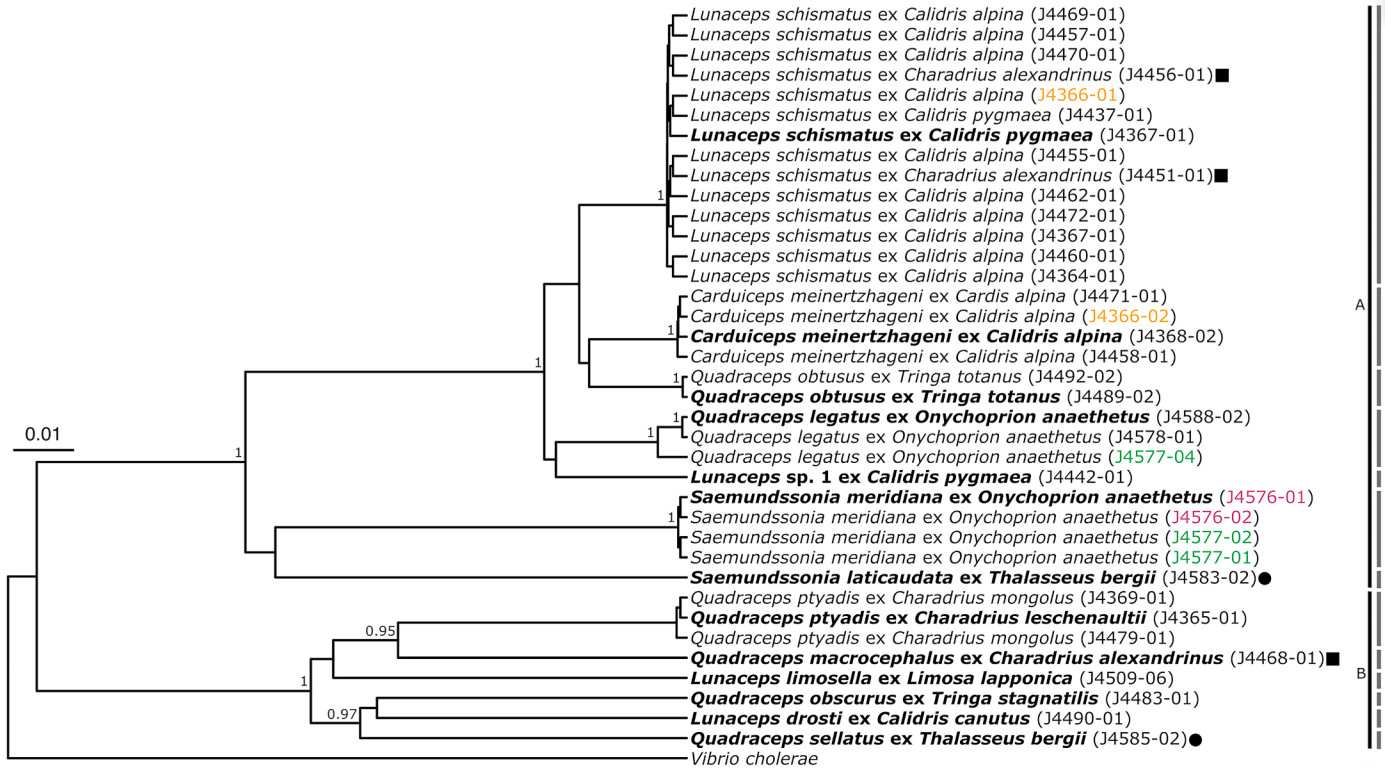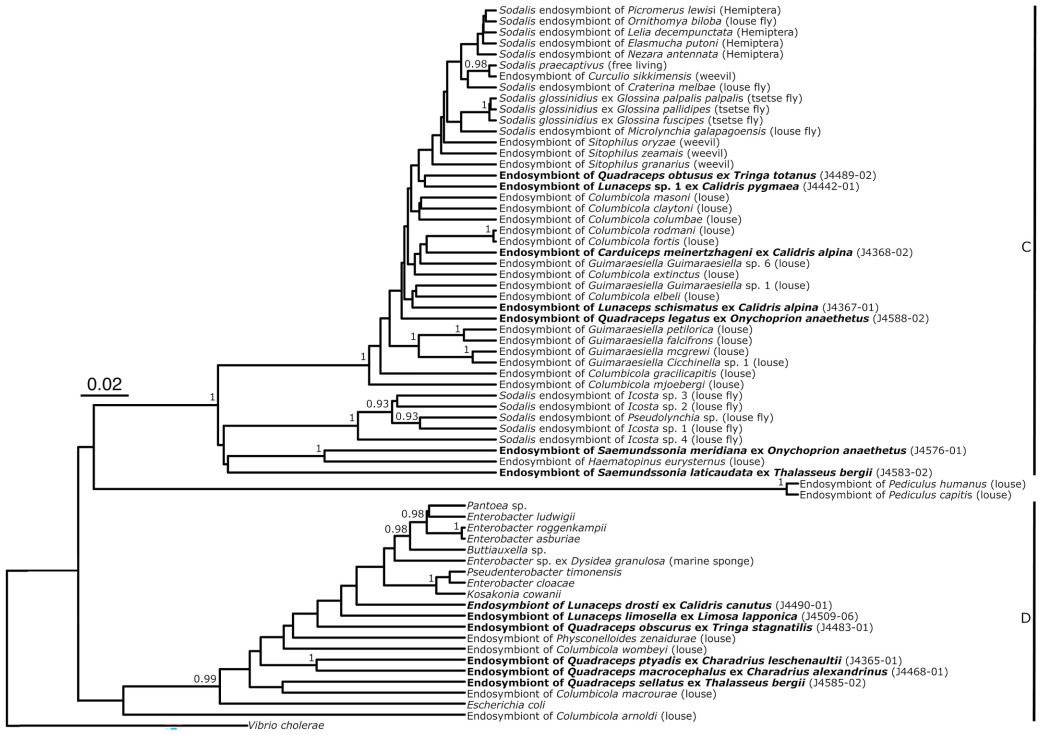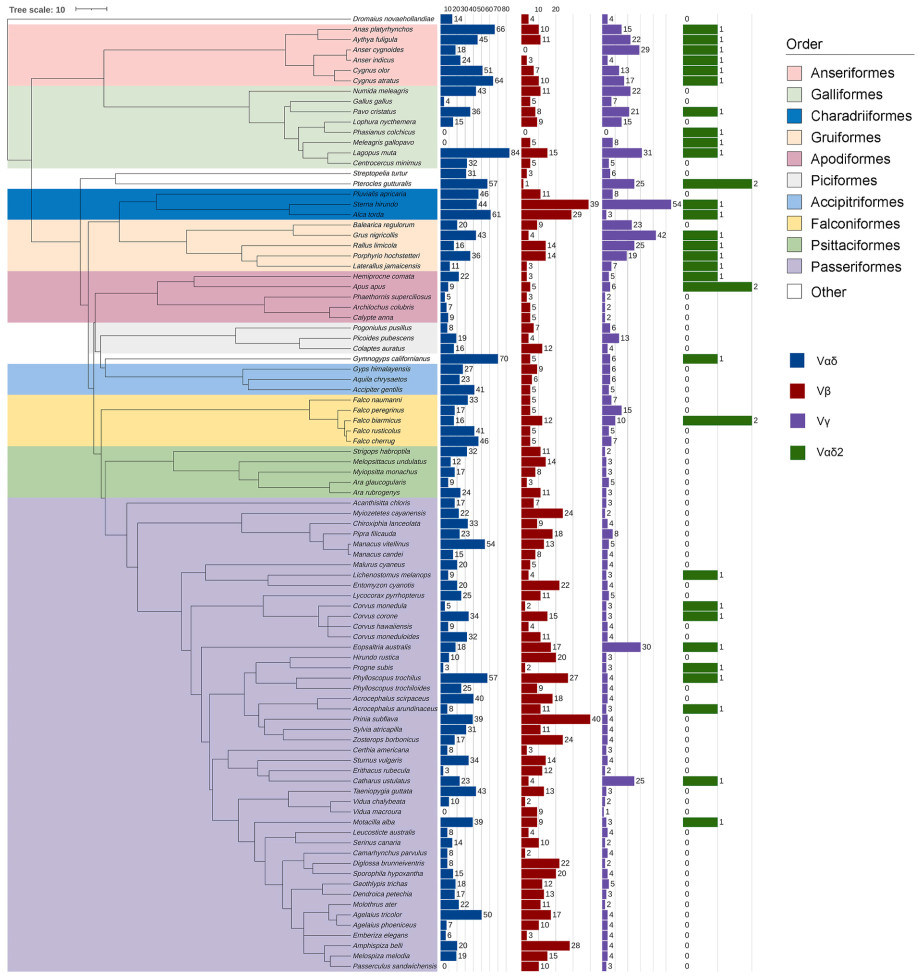Anonymity, 2023. TCR diversity underpins immunotherapy success. Cancer Discov. 13, 1031–1032.
|
Agudo, R., Carrete, M., Alcaide, M., Rico, C., Hiraldo, F., Donázar, J.A., 2012. Genetic diversity at neutral and adaptive loci determines individual fitness in a long-lived territorial bird. Proc. Biol. Sci. 279, 3241–3249.
|
Arstila, T.P., Casrouge, A., Baron, V., Even, J., Kanellopoulos, J., Kourilsky, P., 1999. A direct estimate of the human alphabeta T cell receptor diversity. Science 286, 958–961.
|
Auld, H., MacIver, D., Klaassen, J., 2004. Heavy rainfall and waterborne disease outbreaks: the Walkerton example. J. Toxicol. Env. Heal. A 67, 1879–1887.
|
Biedrzycka, A., Bielański, W., Ćmiel, A., Solarz, W., Zając, T., Migalska, M., et al., 2018. Blood parasites shape extreme major histocompatibility complex diversity in a migratory passerine. Mol. Ecol. 27, 2594–2603.
|
Bush, S.E., Clayton, D.H., 2018. Anti-parasite behaviour of birds. Philos. T. Roy. Soc. B 373, 20170196.
|
Chen, C., Chen, H., Zhang, Y., Thomas, H.R., Frank, M.H., He, Y., et al., 2020. TBtools: an integrative toolkit developed for interactive analyses of big biological data. Mol. Plant 13, 1194–1202.
|
Chen, L., Qiu, Q., Jiang, Y., Wang, K., Lin, Z., Li, Z., et al., 2019. Large-scale ruminant genome sequencing provides insights into their evolution and distinct traits. Science 364, eaav6202.
|
Chen, Y., Xiang, L., Chen, P., Zhao, H., 2023. Vultures as a model for testing molecular adaptations of dietary specialization in birds. Avian Res. 14, 100128.
|
Cheng, Y., Miller, M.J., Zhang, D., Xiong, Y., Hao, Y., Jia, C., et al., 2021. Parallel genomic responses to historical climate change and high elevation in East Asian songbirds. P. Natl. Acad. Sci. U.S.A. 118, e2023918118.
|
Cichoń, M., Dubiec, A., 2005. Cell-mediated immunity predicts the probability of local recruitment in nestling blue tits. J. Evol. Biol. 18, 962–966.
|
Davies, C.S., Worsley, S.F., Maher, K.H., Komdeur, J., Burke, T., Dugdale, H.L., et al., 2022. Immunogenetic variation shapes the gut microbiome in a natural vertebrate population. Microbiome 10, 41.
|
Davis, M.M., Bjorkman, P.J., 1988. T-cell antigen receptor genes and T-cell recognition. Nature 334, 395–402.
|
Dunn, P.O., Bollmer, J.L., Freeman-Gallant, C.R., Whittingham, L.A., 2013. MHC variation is related to a sexually selected ornament, survival, and parasite resistance in common yellowthroats. Evolution 67, 679–687.
|
Fleischer, R., Schmid, D.W., Wasimuddin, Brändel, S.D., Rasche, A., Corman, V.M., et al., 2022. Interaction between MHC diversity and constitution, gut microbiota and Astrovirus infections in a neotropical bat. Mol. Ecol. 31, 3342–3359.
|
Früh, S.P., Früh, M.A., Kaufer, B.B., Göbel, T.W., 2024. Unraveling the chicken T cell repertoire with enhanced genome annotation. Front. Immunol. 15, 1359169.
|
Gurevich, A., Saveliev, V., Vyahhi, N., Tesler, G., 2013. QUAST: quality assessment tool for genome assemblies. Bioinformatics 29, 1072–1075.
|
Hao, Y., Xiong, Y., Cheng, Y., Song, G., Jia, C., Qu, Y., et al., 2019. Comparative transcriptomics of 3 high-altitude passerine birds and their low-altitude relatives. P. Natl. Acad. Sci. U.S.A. 116, 11851–11856.
|
He, K., Minias, P., Dunn, P., 2020. Long-read genome assemblies reveal extraordinary variation in the number and structure of MHC loci in birds. Genome Biol. Evol. 13, evaa270.
|
Huang, X., Chen, Z., Yang, G., Xia, C., Luo, Q., Gao, X., et al., 2022. Assemblages of Plasmodium and related parasites in birds with different migration statuses. Int. J. Mol. Sci. 23, 10277.
|
Irla, M., 2022. Instructive cues of thymic T cell selection. Ann. Rev. Immunol. 40, 95–119.
|
Jarvis, E.D., Mirarab, S., Aberer, A.J., Li, B., Houde, P., Li, C., et al., 2014. Whole-genome analyses resolve early branches in the tree of life of modern birds. Science 346, 1320–1331.
|
Knafler, G.J., Clark, J.A., Boersma, P.D., Bouzat, J.L., 2012. MHC diversity and mate choice in the magellanic penguin, Spheniscus magellanicus. J. Hered. 103, 759–768.
|
Liang, C., Sun, L., Zhu, Y., Wu, J., Zhao, A., Huang, T., et al., 2024. Local chicken breeds exhibit abundant TCR-V segments but similar repertoire diversity. Dev. Comp. Immunol. 157, 105196.
|
Liang, C., Sun, L., Zhu, Y., Zhao, A., Liu, H., He, K., 2023. Macroevolution of avian T cell receptor C segments using genomic data. Immunogenetics 75, 531–541.
|
Liu, F., Li, J., Lin, I.Y.C., Yang, X., Ma, J., Chen, Y., et al., 2020. The genome esequencing of TCR loci in Gallus gallus revealed their distinct evolutionary features in avians. Immunohorizons 4, 33–46.
|
Luzuriaga-Neira, A.R., Alvarez-Ponce, D., 2022. Rates of protein evolution across the marsupial phylogeny: heterogeneity and link to life-history traits. Genome Biol. Evol. 14, evab277.
|
Merelli, I., Guffanti, A., Fabbri, M., Cocito, A., Furia, L., Grazini, U., et al., 2010. RSSsite: a reference database and prediction tool for the identification of cryptic Recombination Signal Sequences in human and murine genomes. Nucleic Acids Res. 38, W262–W267.
|
Migalska, M., Sebastian, A., Radwan, J., 2019. Major histocompatibility complex class I diversity limits the repertoire of T cell receptors. P. Natl. Acad. Sci. U.S.A. 116, 5021–5026.
|
Migalska, M., Węglarczyk, K., Dudek, K., Homa, J., 2024. Evolutionary trade-offs constraining the MHC gene expansion: beyond simple TCR depletion model. Front. Immunol. 14, 1240723.
|
Minias, P., Gutiérrez, J.S., Dunn, P.O., 2020. Avian major histocompatibility complex copy number variation is associated with helminth richness. Biol. Lett. 16, 20200194.
|
Minias, P., Pikus, E., Whittingham, L.A., Dunn, P.O., 2019. Evolution of copy number at the MHC varies across the avian tree of life. Genome Biol. Evol. 11, 17–28.
|
Minias, P., Whittingham, L.A., Dunn, P.O., 2017. Coloniality and migration are related to selection on MHC genes in birds. Evolution 71, 432–441.
|
O'Connor, E.A., Cornwallis, C.K., Hasselquist, D., Nilsson, J., Westerdahl, H., 2018. The evolution of immunity in relation to colonization and migration. Nat. Ecol. Evol. 2, 841–849.
|
O'Connor, E.A., Hasselquist, D., Nilsson, J., Westerdahl, H., Cornwallis, C.K., 2020. Wetter climates select for higher immune gene diversity in resident, but not migratory, songbirds. Proc. Biol. Sci. 287, 20192675.
|
Okanga, S., Cumming, G.S., Hockey, P.A., 2013. Avian malaria prevalence and mosquito abundance in the Western Cape, South Africa. Malaria J 12, 370.
|
Orme, D., Freckleton, R.P., Thomas, G.H., Petzoldt, T., 2013. Caper: comparative analyses of phylogenetics and evolution in R. Methods Ecol. Evol. 3, 145–151.
|
Pagel, M., 1997. Inferring evolutionary processes from phylogenies. Zool. Scr. 26, 331–483.
|
Parra, Z.E., Miller, R.D., 2012. Comparative analysis of the chicken TCRα/δ locus. Immunogenetics 64, 641–645.
|
Podos, J., Webster, M.S., 2022. Ecology and evolution of bird sounds. Curr. Biol. 32, R1100–R1104.
|
Pond, S.L., Frost, S.D., Muse, S.V., 2005. HyPhy: hypothesis testing using phylogenies. Bioinformatics 21, 676–679.
|
Promerová, M., Králová, T., Bryjová, A., Albrecht, T., Bryja, J., 2013. MHC class ⅡB exon 2 polymorphism in the Grey partridge ( Perdix perdix) is shaped by selection, recombination and gene conversion. PLoS One 8, e69135.
|
Qu, Y., Chen, C., Chen, X., Hao, Y., She, H., Wang, M., et al., 2021. The evolution of ancestral and species-specific adaptations in snowfinches at the Qinghai-Tibet Plateau. P. Natl. Acad. Sci. U.S.A. 118, e2012398118.
|
|
Robinson, J., Halliwell, J.A., McWilliam, H., Lopez, R., Marsh, S.G., 2013. IPD–the immuno polymorphism database. Nucleic Acids Res. 41, D1234–D1240.
|
Roche, B., Lebarbenchon, C., Gauthier-Clerc, M., Chang, C.M., Thomas, F., Renaud, F., et al., 2009. Water-borne transmission drives avian influenza dynamics in wild birds: the case of the 2005–2006 epidemics in the Camargue area. Infect. Genet. Evol. 9, 800–805.
|
Rogers, E.J., McGuire, L., Longstaffe, F.J., Clerc, J., Kunkel, E., Fraser, E., 2022. Relating wing morphology and immune function to patterns of partial and differential bat migration using stable isotopes. J. Anim. Ecol. 91, 858–869.
|
Ruiz, M.O., Chaves, L.F., Hamer, G.L., Sun, T., Brown, W.M., Walker, E.D., et al., 2010. Local impact of temperature and precipitation on West Nile virus infection in Culex species mosquitoes in Northeast Illinois, USA. Parasit. Vectors 3, 19.
|
Saino, N., Szép, T., Ambrosini, R., Romano, M., Møller, A.P., 2004. Ecological conditions during winter affect sexual selection and breeding in a migratory bird. Proc. Biol. Sci. 271, 681–686.
|
Schwenke, R.A., Lazzaro, B.P., Wolfner, M.F., 2016. Reproduction-immunity trade-offs in insects. Ann. Rev. Entomol. 61, 239–256.
|
Sepil, I., Lachish, S., Hinks, A.E., Sheldon, B.C., 2013. Mhc supertypes confer both qualitative and quantitative resistance to avian malaria infections in a wild bird population. Proc. Biol. Sci. 280, 20130134.
|
Shah, K., Al-Haidari, A., Sun, J., Kazi, J.U., 2021. T cell receptor (TCR) signaling in health and disease. Signal Transduct. Target. Ther. 6, 412.
|
Tieleman, B.I., 2018. Understanding immune function as a pace of life trait requires environmental context. Behav. Ecol. Sociobiol. 72, 55.
|
Tobias, J.A., Sheard, C., Pigot, A.L., Devenish, A.J.M., Yang, J., Sayol, F., et al., 2022. AVONET: morphological, ecological and geographical data for all birds. Ecol. Lett. 25, 581–597.
|
Vidović, D., Matzinger, P., 1988. Unresponsiveness to a foreign antigen can be caused by self-tolerance. Nature 336, 222–225.
|
Vinkler, M., Fiddaman, S.R., Těšický, M., O'Connor, E.A., Savage, A.E., Lenz, T.L., et al., 2023. Understanding the evolution of immune genes in jawed vertebrates. J. Evol. Biol. 36, 847–873.
|
Wang, Y., Wang, C., Hong, W., Tian, S., Lu, Q., Wang, B.J., et al., 2023a. Genomic analysis of Tibetan ground tits identifies molecular adaptations associated with cooperative breeding. Curr. Zool. 69, 620–630.
|
Wang, Z., Wang, Y.W., Kasuga, T., Hassler, H., Lopez-Giraldez, F., Dong, C., et al., 2023b.
Origins of lineage-specific elements via gene duplication, relocation, and regional rearrangement in Neurospora crassa. Mol. Ecol. .
|
Westerdahl, H., Waldenström, J., Hansson, B., Hasselquist, D., von Schantz, T., Bensch, S., 2005. Associations between malaria and MHC genes in a migratory songbird. Proc. Biol. Sci. 272, 1511–1518.
|
Westerdahl, H., Wittzell, H., von Schantz, T., Bensch, S., 2004. MHC class I typing in a songbird with numerous loci and high polymorphism using motif-specific PCR and DGGE. Heredity 92, 534–542.
|
Yang, H., Wang, Y., Jia, Z., Wang, Y., Yang, X., Wu, P., et al., 2021. Characteristics of T-cell receptor repertoire and correlation with EGFR mutations in all stages of lung cancer. Front. Oncol. 11, 537735.
|
Yang, Z., Sun, Y., Ma, Y., Li, Z., Zhao, Y., Ren, L., et al., 2017. A comprehensive analysis of the germline and expressed TCR repertoire in White Peking duck. Sci. Rep. 7, 41426.
|
Zhang, L., Liu, Y., Meng, G., Liang, R., Zhang, B., Xia, C., 2020. Structural and biophysical insights into the TCRαβ complex in chickens. iScience 23, 101828.
|
Zou, D., Tian, S., Zhang, T., Zhuoma, N., Wu, G., Wang, M., et al., 2021. Vulture genomes reveal molecular adaptations underlying obligate scavenging and low levels of genetic diversity. Mol. Biol. Evol. 38, 3649–3663.
|



 DownLoad:
DownLoad:









 Email Alerts
Email Alerts RSS Feeds
RSS Feeds